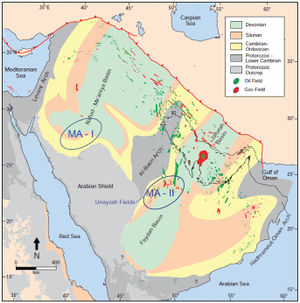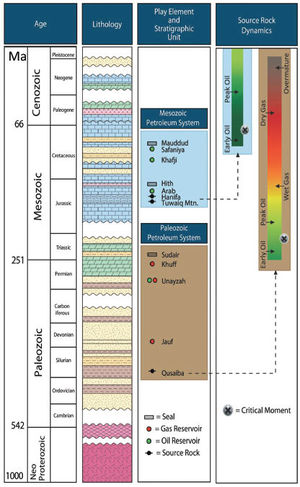Difference between revisions of "Silurian Qusaiba shales"
| Line 15: | Line 15: | ||
}} | }} | ||
==Geological Settings== | ==Geological Settings== | ||
| − | The geological history of the [[Arabian Basin]], which is a part of the [[Arabian Plate]] ([[:file:M114CH01FG01.jpg|Figure 1]]), has been discussed in detail (e.g., Powers et al., 1966<ref name=Powersetal1966>Powers, R. W., L. F. Ramirez, D. D. Redmond, and E. L. Elberg Jr., 1966, Geology of the Arabian peninsula, sedimentary geology of Saudi Arabia: USGS Professional Paper, 560-D, 150 p.</ref>; McGillivray and Al-Husseini, 1992<ref name=McGillivrayandalhusseini1992>McGillivray, J. G., and M. I. Al-Husseini, 1992, The Paleozoic petroleum geology of central Arabia: AAPG Bulletin, v. 76, p. 1473–1490.</ref>; Alsharhan and Nairn, 1997<ref name=Alsharhanandnairn1997>Alsharhan, A. S. and A. E. M. Nairn, 1997, Sedimentary basins and petroleum geology of the Middle East: Elsevier Science B.V., Amsterdam, 843 p.</ref>; Wender et al., 1998<Wenderetal1998>Wender, L. E., J. W. Bryant, M. F. Dickens, A. S. Neville, and A. M. Al-Moqbel, 1998, Paleozoic (Pre-Khuff) hydrocarbon geology of the Ghawar Area, eastern Saudi Arabia: GeoArabia, v. 3, p. 273–302.</ref>; Al-Hajri and Owens, 2000<ref name=Alhajriandowens2000>Al-Hajri, S., and B. Owens, 2000, Sub-surface palynostratigraphy of the Palaeozoic of Saudi Arabia, in S. Al-Hajri and B. Owens, eds., Stratigraphic palynology of the Palaeozoic of Saudi Arabia: GeoArabia Special Publication 1, Gulf PetroLink, Bahrain, p. 10–17.</ref>; Al-Husseini, 2000<ref name=Alhusseini2000>Al-Husseini, M. I., 2000, Origin of the Arabian plate structures: Amar collision and Najd rift: GeoArabia, v. 5, no. 4, p. 527–542.</ref>; Konert et al., 2001<ref name=Konertetal2001>Konert, G., A. M. Afifi, S. A. Al-Hajri, and H. J. Droste, 2001, Paleozoic stratigraphy and hydrocarbon habitat of the Arabian plate: GeoArabia, v. 6, no. 3, p. 407–442.</ref>; Sharland et al., 2001<ref name=Sharlandetal2001>Sharland, P. R., R. Archer, D. M. Casey, R. B. Davies, S. H. Hall, A. P. Heward, et al. 2001, Arabian plate sequence stratigraphy: GeoArabia Special Publication 2, Gulf PetroLink, Bahrain, 371 p.</ref>; Ziegler, 2001<ref name=Ziegler2001>Ziegler, M. A., 2001, Late Permian to Holocene paleofacies evolution of the Arabian Plate and its hydrocarbon occurrences: GeoArabia, v. 6, p. 445–504.</ref>; Faqira et al., 2009<ref name=Faqiraetal2009>Faqira, M., M. Rademakers, and A. M. Afifi, 2009, New insights into the Hercynian orogeny, and their implications for the Paleozoic hydrocarbon system in the Arabian plate: GeoArabia, v. 14, no. 3, p. 199–228.</ref>; Cantrell et al., 2014<ref name=Cantrelletal2014>Cantrell, D. L., P. G. Nicholson, G. W. Hughes, M. A. Miller, A. G. Bhullar, S. T. Abdelbagi et al., 2014, Tethyan petroleum systems of Saudi Arabia, in L. Marlow, C. Kendall, and L. Yose, eds., Petroleum systems of the Tethyan region: AAPG Memoir 106, p. 613–639.</ref> and references cited therein). | + | The geological history of the [[Arabian Basin]], which is a part of the [[Arabian Plate]] ([[:file:M114CH01FG01.jpg|Figure 1]]), has been discussed in detail (e.g., Powers et al., 1966<ref name=Powersetal1966>Powers, R. W., L. F. Ramirez, D. D. Redmond, and E. L. Elberg Jr., 1966, Geology of the Arabian peninsula, sedimentary geology of Saudi Arabia: USGS Professional Paper, 560-D, 150 p.</ref>; McGillivray and Al-Husseini, 1992<ref name=McGillivrayandalhusseini1992>McGillivray, J. G., and M. I. Al-Husseini, 1992, The Paleozoic petroleum geology of central Arabia: AAPG Bulletin, v. 76, p. 1473–1490.</ref>; Alsharhan and Nairn, 1997<ref name=Alsharhanandnairn1997>Alsharhan, A. S. and A. E. M. Nairn, 1997, Sedimentary basins and petroleum geology of the Middle East: Elsevier Science B.V., Amsterdam, 843 p.</ref>; Wender et al., 1998<ref name=Wenderetal1998>Wender, L. E., J. W. Bryant, M. F. Dickens, A. S. Neville, and A. M. Al-Moqbel, 1998, Paleozoic (Pre-Khuff) hydrocarbon geology of the Ghawar Area, eastern Saudi Arabia: GeoArabia, v. 3, p. 273–302.</ref>; Al-Hajri and Owens, 2000<ref name=Alhajriandowens2000>Al-Hajri, S., and B. Owens, 2000, Sub-surface palynostratigraphy of the Palaeozoic of Saudi Arabia, in S. Al-Hajri and B. Owens, eds., Stratigraphic palynology of the Palaeozoic of Saudi Arabia: GeoArabia Special Publication 1, Gulf PetroLink, Bahrain, p. 10–17.</ref>; Al-Husseini, 2000<ref name=Alhusseini2000>Al-Husseini, M. I., 2000, Origin of the Arabian plate structures: Amar collision and Najd rift: GeoArabia, v. 5, no. 4, p. 527–542.</ref>; Konert et al., 2001<ref name=Konertetal2001>Konert, G., A. M. Afifi, S. A. Al-Hajri, and H. J. Droste, 2001, Paleozoic stratigraphy and hydrocarbon habitat of the Arabian plate: GeoArabia, v. 6, no. 3, p. 407–442.</ref>; Sharland et al., 2001<ref name=Sharlandetal2001>Sharland, P. R., R. Archer, D. M. Casey, R. B. Davies, S. H. Hall, A. P. Heward, et al. 2001, Arabian plate sequence stratigraphy: GeoArabia Special Publication 2, Gulf PetroLink, Bahrain, 371 p.</ref>; Ziegler, 2001<ref name=Ziegler2001>Ziegler, M. A., 2001, Late Permian to Holocene paleofacies evolution of the Arabian Plate and its hydrocarbon occurrences: GeoArabia, v. 6, p. 445–504.</ref>; Faqira et al., 2009<ref name=Faqiraetal2009>Faqira, M., M. Rademakers, and A. M. Afifi, 2009, New insights into the Hercynian orogeny, and their implications for the Paleozoic hydrocarbon system in the Arabian plate: GeoArabia, v. 14, no. 3, p. 199–228.</ref>; Cantrell et al., 2014<ref name=Cantrelletal2014>Cantrell, D. L., P. G. Nicholson, G. W. Hughes, M. A. Miller, A. G. Bhullar, S. T. Abdelbagi et al., 2014, Tethyan petroleum systems of Saudi Arabia, in L. Marlow, C. Kendall, and L. Yose, eds., Petroleum systems of the Tethyan region: AAPG Memoir 106, p. 613–639.</ref> and references cited therein). |
[[file:M114CH01FG01.jpg|300px|thumb|{{figure number|1}}Oil and gas fields in the [[Arabian Plate]] and distribution of [[Silurian]] Qusaiba [[shale]]s beneath [[Hercynian]] unconformity (after Faqira et al., 2009<ref name=Faqiraetal2009 />). MA-I and MA-II show the two areas selected for a 2-D basin modeling study. The [[Unayzah]] fields contain oil sourced by Qusaiba shales.]] | [[file:M114CH01FG01.jpg|300px|thumb|{{figure number|1}}Oil and gas fields in the [[Arabian Plate]] and distribution of [[Silurian]] Qusaiba [[shale]]s beneath [[Hercynian]] unconformity (after Faqira et al., 2009<ref name=Faqiraetal2009 />). MA-I and MA-II show the two areas selected for a 2-D basin modeling study. The [[Unayzah]] fields contain oil sourced by Qusaiba shales.]] | ||
| Line 34: | Line 34: | ||
With respect to the [[Paleozoic Petroleum System]] (PPS), early [[Silurian]] time has prime importance due to deposition of organic-rich (hot) [[shale]]s in a large shelf area of the [[Gondwana]] covering present-day [[North Africa]] and the [[Arabian Peninsula]] (Klemme and Ulmishek, 1991<ref name=Klemmeandulmishek1991>Klemme, H. D., and G. F. Ulmishek, 1991, Effective petroleum source rocks of the world: Stratigraphic distribution and controlling depositional factors: AAPG Bulletin, v. 75, p. 1809–1851.</ref>). Lower [[Silurian]] organic-rich (hot) [[shale]]s have generated about 80–90% of the [[Paleozoic]] sourced [[hydrocarbon]]s in [[North Africa]] and the [[Arabian Peninsula]] (Klemme and Ulmishek, 1991<ref name=Klemmeandulmishek1991 />). The lower hot [[shale]]s, of the [[Qusaiba Formation]] of the [[Qalibah Group]] in [[Saudi Arabia]], are major source rocks of the [[Paleozoic]] oil and gas accumulations in the [[Arabian Peninsula]] (Alsharhan and Nairn, 1997<ref name=Alsharhanandnairn1997 />). In most cases, the shales were deposited directly above upper [[Ordovician]] [[periglacial]] [[sandstone]]s during the initial early [[Silurian]] [[transgression]] that was a result of the melting of the late [[Ordovician]] [[ice cap]] (Lüning et al., 2000<ref name=Luningetal2000>Lüning, S., J. Craig, D. K. Loydell, P. Storch, and B. Fitches, 2000, Lower Silurian “hot shales” in North Africa and Arabia: Regional distribution and depositional model: Earth Science Reviews, v. 49, p. 121–200.</ref>). | With respect to the [[Paleozoic Petroleum System]] (PPS), early [[Silurian]] time has prime importance due to deposition of organic-rich (hot) [[shale]]s in a large shelf area of the [[Gondwana]] covering present-day [[North Africa]] and the [[Arabian Peninsula]] (Klemme and Ulmishek, 1991<ref name=Klemmeandulmishek1991>Klemme, H. D., and G. F. Ulmishek, 1991, Effective petroleum source rocks of the world: Stratigraphic distribution and controlling depositional factors: AAPG Bulletin, v. 75, p. 1809–1851.</ref>). Lower [[Silurian]] organic-rich (hot) [[shale]]s have generated about 80–90% of the [[Paleozoic]] sourced [[hydrocarbon]]s in [[North Africa]] and the [[Arabian Peninsula]] (Klemme and Ulmishek, 1991<ref name=Klemmeandulmishek1991 />). The lower hot [[shale]]s, of the [[Qusaiba Formation]] of the [[Qalibah Group]] in [[Saudi Arabia]], are major source rocks of the [[Paleozoic]] oil and gas accumulations in the [[Arabian Peninsula]] (Alsharhan and Nairn, 1997<ref name=Alsharhanandnairn1997 />). In most cases, the shales were deposited directly above upper [[Ordovician]] [[periglacial]] [[sandstone]]s during the initial early [[Silurian]] [[transgression]] that was a result of the melting of the late [[Ordovician]] [[ice cap]] (Lüning et al., 2000<ref name=Luningetal2000>Lüning, S., J. Craig, D. K. Loydell, P. Storch, and B. Fitches, 2000, Lower Silurian “hot shales” in North Africa and Arabia: Regional distribution and depositional model: Earth Science Reviews, v. 49, p. 121–200.</ref>). | ||
| + | |||
| + | [[file:M114CH01FG04.jpg|300px|thumb|{{figure number|4}}Petroleum systems of the [[Arabian Basin]] (modified after Cantrell et al., 2014<ref name=Cantrelletal2014 />).]] | ||
==Petroleum systems== | ==Petroleum systems== | ||
| − | Recently, Cantrell et al. (2014) reviewed the Tethyan Petroleum | + | Recently, Cantrell et al. (2014)<ref name=Cantrelletal2014 /> reviewed the [[Tethyan Petroleum System]]s of [[Saudi Arabia]] where they describe two major petroleum systems: the [[Paleozoic Petroleum System|PPS]] related to the Paleo-Tethys and a [[Mesozoic Petroleum System]] (MPS) associated with the Neo-Tethys ([[:file:M114CH01FG04.jpg|Figure 4]]). The elements of the two petroleum systems (e.g., [[source]], [[reservoir]], and [[seal]] characteristics) show significant differences. The [[Paleozoic Petroleum System|PPS]] is [[siliciclastic]]-dominated, whereas the [[Mesozoic Petroleum System|MPS]] is [[carbonate]]-dominated. These two petroleum systems are separated in geological time by the closure of the Paleo-Tethys and the amalgamation of [[Pangea]], followed by subsequent breakup of [[Pangea]] and opening of the Neo-Tethys (Cantrell et al., 2014). |
| − | The key elements of the MPS are shown in Figure 4. The MPS contains the Jurassic Hanifa and Tuwaiq Mountain Formations as the principal source rocks, with an average resident TOC content of about 3.5 wt.%, and sometimes as high as 14.3 wt.% (Cantrell et al., 2014). The reservoirs extend from the Middle Jurassic to Upper Cretaceous | + | The key elements of the [[Mesozoic Petroleum System|MPS]] are shown in [[:file:M114CH01FG04.jpg|Figure 4]]. The [[Mesozoic Petroleum System|MPS]] contains the [[Jurassic]] [[Hanifa Formation|Hanifa]] and [[Tuwaiq Mountain Formation|Tuwaiq Mountain]] Formations as the principal source rocks, with an average resident [[TOC]] content of about 3.5 wt.%, and sometimes as high as 14.3 wt.% (Cantrell et al., 2014<ref name=Cantrelletal2014 />). The reservoirs extend from the Middle [[Jurassic]] to Upper [[Cretaceous]] [[carbonate]]s (the major reservoir being the [[Arab Formation]]). Regional [[seal]]s are provided by Arab [[anhydrite]]s and the evaporitic [[Hith Formation]]. The [[Mesozoic Petroleum System|MPS]] has been previously discussed in detail (e.g., Carrigan et al., 1994<ref name-Carriganetal1994>Carrigan, W. J., G. A. Cole, E. L. Colling, and P. J. Jones, 1994, Geochemistry of the Upper Jurassic Tuwaiq Mountain and Hanifa Formation petroleum source rocks of eastern Saudi Arabia, in B. J. Katz, ed., Petroleum source rocks: Springer-Verlag, New York, p. 67–87.</ref>; Cole et al., 1994<ref name=Coleetal1994>Cole, G. A., M. A. AbuAli, S. M. Aoudeh, W. J. Carrigan, H. H. Chen, E. L. Colling, et al., 1994, Organic geochemistry of the Paleozoic petroleum system of Saudi Arabia: Energy & Fuels, v. 8, p. 1425–1442.</ref>; Cantrell et al., 2014<ref name=Cantrelletal2014 />). |
| − | Paleozoic Petroleum | + | [[Paleozoic Petroleum System]]s: A summary of the PPS is shown in [[:file:M114CH01FG04.jpg|Figure 4]]. This petroleum system contains the basal [[Silurian]] Qusaiba hot [[shale]], and to a lesser extent the Qusaiba warm [[shale]]s, as its principal source rocks, with reservoirs extending from the [[Ordovician]] to the early [[Triassic]]. [[Seal]]s occur at different stratigraphic levels, with the evaporitic [[Sudair Formation]] of the early [[Triassic]] age serving as the regional top seal of the PPS. Hanadir and Ra’an shales of the [[Ordovician]] [[Qasim Formation]] may also present some source potential. |
| − | Source Rocks: Although several intervals of fine | + | Source Rocks: Although several intervals of fine [[clastic]]s (e.g., [[shale]]s and [[mudstone]]) are potential source rocks of various organic richness, the basal hot [[shale]] member of the [[Qusaiba Formation]] of the [[Qalibah Group]] ([[:file:M114CH01FG02.jpg|Figure 2]]) shows a basin-wide occurrence ([[:file:M114CH01FG01.jpg|Figure 1]]) and is organic rich (Cole et al., 1994<ref name=Coleetal1994 />). Termination of [[glaciation]] at the end of the [[Ordovician]] resulted in a major sea-level rise during the early [[Silurian]] time, leading to deposition of the upward-coarsening [[progradation]]al [[Qalibah Group]]. This rapid [[transgression]] caused displacement of earlier shallow marine [[siliciclastic]]s and resulted in the deposition of organic-rich sediments within [[anoxic]] intra-shelf depressions of the northern [[Gondwana]] (Jones and Stump, 1999<ref name=Jonesandstump1999>Jones, P. J., and T. Stump, 1999, Depositional and tectonic setting of the Lower Silurian hydrocarbon source rock facies, Central Saudi Arabia: AAPG Bulletin, v. 83, p. 314–332.</ref>). As these intra-shelf depressions were filled with [[anoxic]] [[sediment]]s, more [[oxic]] depositional environment led to a widespread deposition of warm, organic-lean [[shale]]s of the [[Qusaiba Formation]] (Lüning et al., 2000<ref name=Lüningetal2000 />). The organic-rich basal hot [[shale]] of the [[Qusaiba Formation]] is best developed in the subsurface of east-central [[Saudi Arabia]], as well as in the northwest Saudi Arabia, and has an average [[TOC]] content of about 5 wt.%, with maximum values as high as 20 wt.% (Cole et al., 1994<ref name=Coleetal1994 />). Several [[Paleozoic]] oil and gas fields in [[Saudi Arabia]] are known to have been sourced from the basal Qusaiba hot [[shale]] (AbuAli et al., 1991<ref name=Abualietal1991>AbuAli, M. A., U. A. Franz, J. Shen, F. Monnier, M. D. Mahmoud, and T. M. Chambers, 1991, Hydrocarbon generation and migration in the Paleozoic sequence of Saudi Arabia: Society of Petroleum Engineers, SPE 21376, p. 345–356.</ref>, 1999<ref name=AbuAlietal1999>AbuAli, M. A., J. L. Rudkiewicz, J. G. McGillivray, and F. Behar, 1999, Paleozoic petroleum system of Central Saudi Arabia: GeoArabia, v. 4, no. 3, p. 321–335.</ref>; Mahmoud et al., 1992<ref name=Mahmoudetal1992 />; McGillivray and Al-Husseini, 1992<ref name=Mcgillivrayandalhusseini1992 />; Cole et al., 1994<ref name=Coleetal1994 />; Jones and Stump, 1999<ref name=Jonesandstump1999 />). This hot shale unit contains type II amorphous organic matter, with [[graptolite]] and [[chitinozoan]]s, and ranges in thickness from 10 to 250 ft (3–70 m) as given by Mahmoud et al. (1992)<ref name=Mahmoudetal1992 />, Wender et al. (1998)<ref name=Wenderetal1998 />, AbuAli et al. (1999)<ref name=AbuAlietal1999 />, and AbuAli and Littke (2005)<ref name=Abualiandlittke2005 />. Within the [[Qusaiba Formation]], a thick sequence of nonradioactive, light to medium gray [[shale]] overlies the basal hot shale. This lean shale still contains poor to moderate [[organic]] richness (up to a few weight percent [[TOC]]) with mixed oil and gas potential (Cole et al., 1994)<ref name=Coleetal1994 />, and due to its thickness, it can also be a volumetrically important source rock for [[hydrocarbon]] resources in [[Saudi Arabia]]. |
Reservoir Rocks: The main reservoirs of the PPS are the sandstones of the Devonian Jauf Formation, sandstones of the Permian Unayzah Formation, and carbonates of the Permian Khuff Formation (Figure 2). The Ordovician Sarah Formation, underlying the regional Qusaiba hot shale source rock, consists mainly of fine- to coarse-grained sandstone sequences of glacial and glacio-fluvial origin. The formation is widely distributed in central and northwestern Saudi Arabia. Cantrell et al. (2014) has noted that pre-Qusaiba clastics (e.g., Sarah sandstones) are generally considered to be tight due to advanced diagenesis, particularly cementation by quartz overgrowths, which has reduced reservoir quality. | Reservoir Rocks: The main reservoirs of the PPS are the sandstones of the Devonian Jauf Formation, sandstones of the Permian Unayzah Formation, and carbonates of the Permian Khuff Formation (Figure 2). The Ordovician Sarah Formation, underlying the regional Qusaiba hot shale source rock, consists mainly of fine- to coarse-grained sandstone sequences of glacial and glacio-fluvial origin. The formation is widely distributed in central and northwestern Saudi Arabia. Cantrell et al. (2014) has noted that pre-Qusaiba clastics (e.g., Sarah sandstones) are generally considered to be tight due to advanced diagenesis, particularly cementation by quartz overgrowths, which has reduced reservoir quality. | ||
Revision as of 21:43, 31 December 2018
| Petroleum Systems Analysis—Case Studies | |
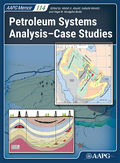
| |
| Series | Memoir |
|---|---|
| Chapter | A petroleum system and basin modeling study of northwest and east-central Saudi Arabia: Effect of burial history and adjacent rock lithology on the gas potential of the Silurian Qusaiba Shales |
| Author | Sedat Inan, Mahdi A. AbuAli, Ahmed M. Hakami |
| Link | Web page |
| Store | AAPG Store |
Geological Settings
The geological history of the Arabian Basin, which is a part of the Arabian Plate (Figure 1), has been discussed in detail (e.g., Powers et al., 1966[1]; McGillivray and Al-Husseini, 1992[2]; Alsharhan and Nairn, 1997[3]; Wender et al., 1998[4]; Al-Hajri and Owens, 2000[5]; Al-Husseini, 2000[6]; Konert et al., 2001[7]; Sharland et al., 2001[8]; Ziegler, 2001[9]; Faqira et al., 2009[10]; Cantrell et al., 2014[11] and references cited therein).
Therefore, only a brief summary will be presented in this chapter, and for details the reader is referred to previous publications. The main tectonic phases that shaped the Arabian Plate include:
- Precambrian (formation of the basement)
- Ordovician-Silurian Glaciation and Deglaciation (Qusaiba shales source rocks deposition)
- Late Devonian to the early Carboniferous (Hercynian Orogeny structural event)
- Late Permian through the Jurassic Zagros Rifting (Gondwana supercontinent fragmentation and drift of the Arabian Plate to the equator with a favorable source and reservoirs pairs development)
- Tertiary Zagros Orogeny (tilt of the Arabian Plate and Zagros thrusting)
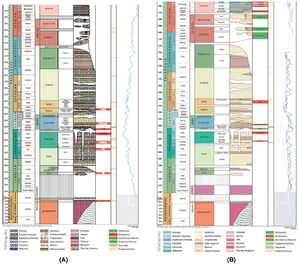
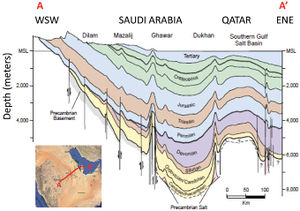
As evidenced from the sedimentary succession (Figure 2), throughout the Paleozoic era, clastic continental and shallow-marine sedimentation prevailed on a stable passive margin on the northeastern Gondwana. The Hercynian events of the Carboniferous affected the area, creating regional uplift, widespread erosion, and basement tectonism due to rejuvenation of the preexisting weaknesses in the basement (Konert et al., 2001[7]). From the Permian to the Eocene, the area was a broad stable passive margin where the deposition of mainly shallow-water carbonates with minor anhydrites and shales occurred (Cantrell et al., 2014[11]). Since the Oligocene, the northeastern part of the basin has been undergoing shortening as a consequence of collision of the Arabian Plate with Laurasia (Zagros Orogeny). The resulting flexure of the Arabian Plate underneath the Zagros fold-and-thrust belt created a wedge-shaped, low-angle (less than 2°) foreland basin (Figure 3), that has been the site of mixed evaporitic, carbonate, and clastic sedimentation.
With respect to the Paleozoic Petroleum System (PPS), early Silurian time has prime importance due to deposition of organic-rich (hot) shales in a large shelf area of the Gondwana covering present-day North Africa and the Arabian Peninsula (Klemme and Ulmishek, 1991[12]). Lower Silurian organic-rich (hot) shales have generated about 80–90% of the Paleozoic sourced hydrocarbons in North Africa and the Arabian Peninsula (Klemme and Ulmishek, 1991[12]). The lower hot shales, of the Qusaiba Formation of the Qalibah Group in Saudi Arabia, are major source rocks of the Paleozoic oil and gas accumulations in the Arabian Peninsula (Alsharhan and Nairn, 1997[3]). In most cases, the shales were deposited directly above upper Ordovician periglacial sandstones during the initial early Silurian transgression that was a result of the melting of the late Ordovician ice cap (Lüning et al., 2000[13]).
Petroleum systems
Recently, Cantrell et al. (2014)[11] reviewed the Tethyan Petroleum Systems of Saudi Arabia where they describe two major petroleum systems: the PPS related to the Paleo-Tethys and a Mesozoic Petroleum System (MPS) associated with the Neo-Tethys (Figure 4). The elements of the two petroleum systems (e.g., source, reservoir, and seal characteristics) show significant differences. The PPS is siliciclastic-dominated, whereas the MPS is carbonate-dominated. These two petroleum systems are separated in geological time by the closure of the Paleo-Tethys and the amalgamation of Pangea, followed by subsequent breakup of Pangea and opening of the Neo-Tethys (Cantrell et al., 2014).
The key elements of the MPS are shown in Figure 4. The MPS contains the Jurassic Hanifa and Tuwaiq Mountain Formations as the principal source rocks, with an average resident TOC content of about 3.5 wt.%, and sometimes as high as 14.3 wt.% (Cantrell et al., 2014[11]). The reservoirs extend from the Middle Jurassic to Upper Cretaceous carbonates (the major reservoir being the Arab Formation). Regional seals are provided by Arab anhydrites and the evaporitic Hith Formation. The MPS has been previously discussed in detail (e.g., Carrigan et al., 1994Cite error: Invalid <ref> tag; invalid names, e.g. too many; Cole et al., 1994[14]; Cantrell et al., 2014[11]).
Paleozoic Petroleum Systems: A summary of the PPS is shown in Figure 4. This petroleum system contains the basal Silurian Qusaiba hot shale, and to a lesser extent the Qusaiba warm shales, as its principal source rocks, with reservoirs extending from the Ordovician to the early Triassic. Seals occur at different stratigraphic levels, with the evaporitic Sudair Formation of the early Triassic age serving as the regional top seal of the PPS. Hanadir and Ra’an shales of the Ordovician Qasim Formation may also present some source potential.
Source Rocks: Although several intervals of fine clastics (e.g., shales and mudstone) are potential source rocks of various organic richness, the basal hot shale member of the Qusaiba Formation of the Qalibah Group (Figure 2) shows a basin-wide occurrence (Figure 1) and is organic rich (Cole et al., 1994[14]). Termination of glaciation at the end of the Ordovician resulted in a major sea-level rise during the early Silurian time, leading to deposition of the upward-coarsening progradational Qalibah Group. This rapid transgression caused displacement of earlier shallow marine siliciclastics and resulted in the deposition of organic-rich sediments within anoxic intra-shelf depressions of the northern Gondwana (Jones and Stump, 1999[15]). As these intra-shelf depressions were filled with anoxic sediments, more oxic depositional environment led to a widespread deposition of warm, organic-lean shales of the Qusaiba Formation (Lüning et al., 2000[16]). The organic-rich basal hot shale of the Qusaiba Formation is best developed in the subsurface of east-central Saudi Arabia, as well as in the northwest Saudi Arabia, and has an average TOC content of about 5 wt.%, with maximum values as high as 20 wt.% (Cole et al., 1994[14]). Several Paleozoic oil and gas fields in Saudi Arabia are known to have been sourced from the basal Qusaiba hot shale (AbuAli et al., 1991[17], 1999[18]; Mahmoud et al., 1992[19]; McGillivray and Al-Husseini, 1992[20]; Cole et al., 1994[14]; Jones and Stump, 1999[15]). This hot shale unit contains type II amorphous organic matter, with graptolite and chitinozoans, and ranges in thickness from 10 to 250 ft (3–70 m) as given by Mahmoud et al. (1992)[19], Wender et al. (1998)[4], AbuAli et al. (1999)[18], and AbuAli and Littke (2005)[21]. Within the Qusaiba Formation, a thick sequence of nonradioactive, light to medium gray shale overlies the basal hot shale. This lean shale still contains poor to moderate organic richness (up to a few weight percent TOC) with mixed oil and gas potential (Cole et al., 1994)[14], and due to its thickness, it can also be a volumetrically important source rock for hydrocarbon resources in Saudi Arabia.
Reservoir Rocks: The main reservoirs of the PPS are the sandstones of the Devonian Jauf Formation, sandstones of the Permian Unayzah Formation, and carbonates of the Permian Khuff Formation (Figure 2). The Ordovician Sarah Formation, underlying the regional Qusaiba hot shale source rock, consists mainly of fine- to coarse-grained sandstone sequences of glacial and glacio-fluvial origin. The formation is widely distributed in central and northwestern Saudi Arabia. Cantrell et al. (2014) has noted that pre-Qusaiba clastics (e.g., Sarah sandstones) are generally considered to be tight due to advanced diagenesis, particularly cementation by quartz overgrowths, which has reduced reservoir quality.
Seal Rocks: The PPS contains a number of regional seals. The pre-Qusaiba reservoirs (e.g., the late Ordovician Sarah sandstone Formation) are sealed by the overlying Lower Silurian Qusaiba hot shale. The major regional seals for the Unayzah reservoirs are the transgressive shales and carbonates of the basal Khuff Formation. The Khuff reservoirs are sealed by the evaporite members associated with each carbonate cycle, and the fine clastics of the Sudair Formation are a regional seal for the PPS (Figure 2).
Petroleum Generation and Entrapment: Previous petroleum system and basin modeling studies of the PPS of the east-central part of the Arabian Basin (AbuAli et al., 1999; AbuAli and Littke, 2005) suggested that maturation and oil generation from the Qusaiba basal hot shales commenced as early as the Triassic. Accordingly, early oil expulsion began at about 210 Ma (Triassic), with peak oil expulsion occurring at about 152 Ma (Late Jurassic) and peak gas expulsion at about 140 Ma (Early Cretaceous) (Figure 4).
Based on modeling results, hydrocarbon expulsion from the Silurian hot shale postdated the main phase of trap formation during mid-Carboniferous basin inversion in east-central Saudi Arabia (Figure 4).
The Silurian Qusaiba shales, mainly basal hot shales and possibly, in a limited manner, the overlying warm shales, owing to organic richness and favorable maturity both in the northwest and east-central Arabian Basin, have sourced Paleozoic oil and gas reservoirs and lately have been considered potential target for unconventional resources.
See also
References
- ↑ Powers, R. W., L. F. Ramirez, D. D. Redmond, and E. L. Elberg Jr., 1966, Geology of the Arabian peninsula, sedimentary geology of Saudi Arabia: USGS Professional Paper, 560-D, 150 p.
- ↑ McGillivray, J. G., and M. I. Al-Husseini, 1992, The Paleozoic petroleum geology of central Arabia: AAPG Bulletin, v. 76, p. 1473–1490.
- ↑ 3.0 3.1 Alsharhan, A. S. and A. E. M. Nairn, 1997, Sedimentary basins and petroleum geology of the Middle East: Elsevier Science B.V., Amsterdam, 843 p.
- ↑ 4.0 4.1 Wender, L. E., J. W. Bryant, M. F. Dickens, A. S. Neville, and A. M. Al-Moqbel, 1998, Paleozoic (Pre-Khuff) hydrocarbon geology of the Ghawar Area, eastern Saudi Arabia: GeoArabia, v. 3, p. 273–302.
- ↑ Al-Hajri, S., and B. Owens, 2000, Sub-surface palynostratigraphy of the Palaeozoic of Saudi Arabia, in S. Al-Hajri and B. Owens, eds., Stratigraphic palynology of the Palaeozoic of Saudi Arabia: GeoArabia Special Publication 1, Gulf PetroLink, Bahrain, p. 10–17.
- ↑ Al-Husseini, M. I., 2000, Origin of the Arabian plate structures: Amar collision and Najd rift: GeoArabia, v. 5, no. 4, p. 527–542.
- ↑ 7.0 7.1 7.2 Konert, G., A. M. Afifi, S. A. Al-Hajri, and H. J. Droste, 2001, Paleozoic stratigraphy and hydrocarbon habitat of the Arabian plate: GeoArabia, v. 6, no. 3, p. 407–442.
- ↑ Sharland, P. R., R. Archer, D. M. Casey, R. B. Davies, S. H. Hall, A. P. Heward, et al. 2001, Arabian plate sequence stratigraphy: GeoArabia Special Publication 2, Gulf PetroLink, Bahrain, 371 p.
- ↑ Ziegler, M. A., 2001, Late Permian to Holocene paleofacies evolution of the Arabian Plate and its hydrocarbon occurrences: GeoArabia, v. 6, p. 445–504.
- ↑ 10.0 10.1 Faqira, M., M. Rademakers, and A. M. Afifi, 2009, New insights into the Hercynian orogeny, and their implications for the Paleozoic hydrocarbon system in the Arabian plate: GeoArabia, v. 14, no. 3, p. 199–228.
- ↑ 11.0 11.1 11.2 11.3 11.4 11.5 Cantrell, D. L., P. G. Nicholson, G. W. Hughes, M. A. Miller, A. G. Bhullar, S. T. Abdelbagi et al., 2014, Tethyan petroleum systems of Saudi Arabia, in L. Marlow, C. Kendall, and L. Yose, eds., Petroleum systems of the Tethyan region: AAPG Memoir 106, p. 613–639.
- ↑ 12.0 12.1 Klemme, H. D., and G. F. Ulmishek, 1991, Effective petroleum source rocks of the world: Stratigraphic distribution and controlling depositional factors: AAPG Bulletin, v. 75, p. 1809–1851.
- ↑ Lüning, S., J. Craig, D. K. Loydell, P. Storch, and B. Fitches, 2000, Lower Silurian “hot shales” in North Africa and Arabia: Regional distribution and depositional model: Earth Science Reviews, v. 49, p. 121–200.
- ↑ 14.0 14.1 14.2 14.3 14.4 Cole, G. A., M. A. AbuAli, S. M. Aoudeh, W. J. Carrigan, H. H. Chen, E. L. Colling, et al., 1994, Organic geochemistry of the Paleozoic petroleum system of Saudi Arabia: Energy & Fuels, v. 8, p. 1425–1442.
- ↑ 15.0 15.1 Jones, P. J., and T. Stump, 1999, Depositional and tectonic setting of the Lower Silurian hydrocarbon source rock facies, Central Saudi Arabia: AAPG Bulletin, v. 83, p. 314–332.
- ↑ Cite error: Invalid
<ref>tag; no text was provided for refs namedLüningetal2000 - ↑ AbuAli, M. A., U. A. Franz, J. Shen, F. Monnier, M. D. Mahmoud, and T. M. Chambers, 1991, Hydrocarbon generation and migration in the Paleozoic sequence of Saudi Arabia: Society of Petroleum Engineers, SPE 21376, p. 345–356.
- ↑ 18.0 18.1 AbuAli, M. A., J. L. Rudkiewicz, J. G. McGillivray, and F. Behar, 1999, Paleozoic petroleum system of Central Saudi Arabia: GeoArabia, v. 4, no. 3, p. 321–335.
- ↑ 19.0 19.1 Cite error: Invalid
<ref>tag; no text was provided for refs namedMahmoudetal1992 - ↑ Cite error: Invalid
<ref>tag; no text was provided for refs namedMcgillivrayandalhusseini1992 - ↑ Cite error: Invalid
<ref>tag; no text was provided for refs namedAbualiandlittke2005
